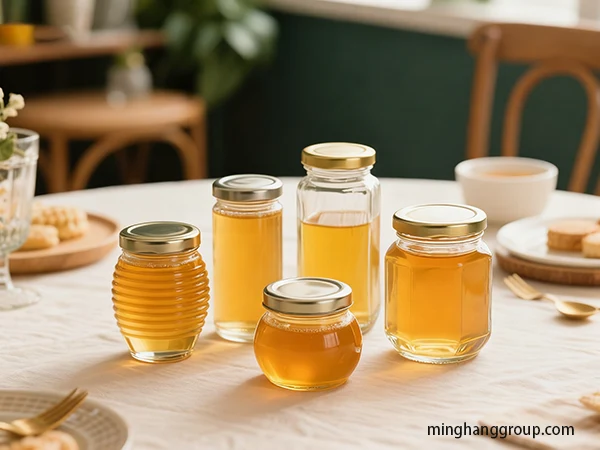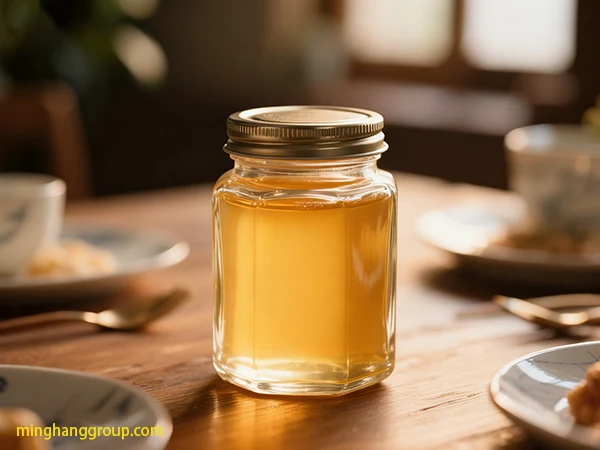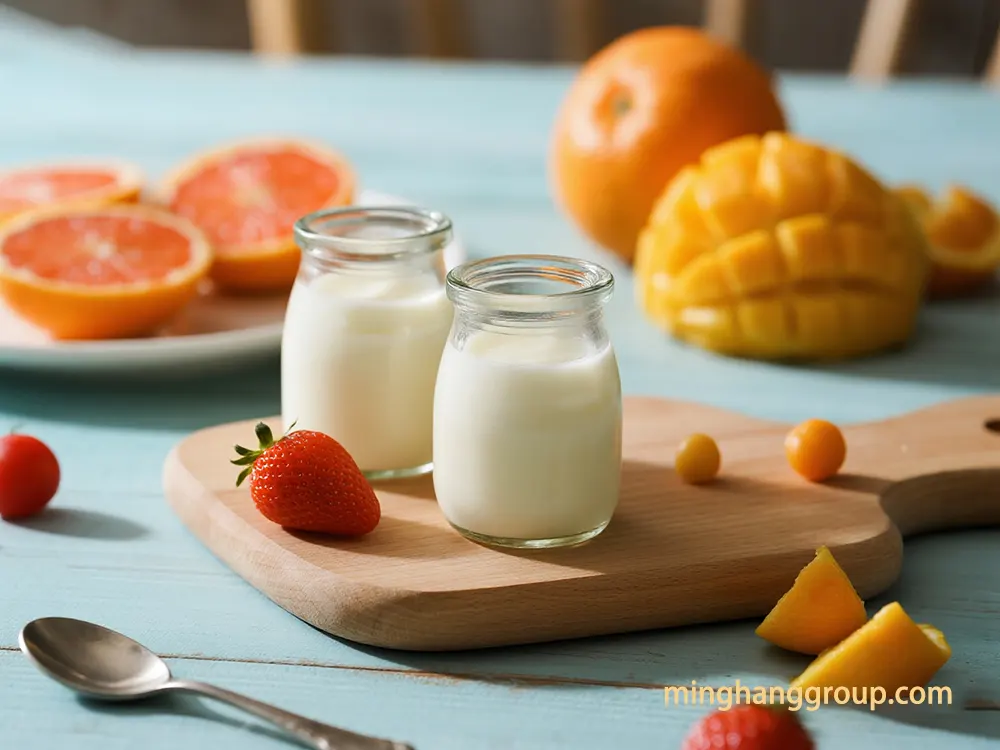Executive Summary
The honey market worldwide is still growing gradually. Its main drivers are the increased demand for natural sweeteners and clean-label products. For packaging buyers, the selection of the appropriate honey jar is more than just a design choice—it is a strategic decision that has an impact on product preservation, branding, logistics, and profitability. This comprehensive report is a detailed manual for honey jar wholesale sourcing and bulk procurement strategies, the focus being on honey packaging from the technical, economic, and sustainability points of view. It provides information on the material used, design optimization, sourcing strategy, cost management, regulatory compliance, and trends. By mastering these concepts, companies can enhance product performance, raise their brand value, and build a sustainable packaging supply chain.

Understanding Honey Jar Material Options
The choice of the materials defines the functionality, eco-friendliness, and visual attractiveness of the glass honey jars and plastic containers. Here we break down the primary materials—glass, PET, and HDPE—that are most frequently found in the honey jar wholesale supply chains.
Among the various containers for honey, glass is still the most elegant and luxurious product and, consequently, is the leading choice for jars packaging in the most affluent segments of the market. Properties: Glass is the safest of the three as it is an inert, non-porous, and impermeable material, therefore there is no risk of any chemical migration into honey. At the same time, it keeps the natural golden color of the product visible and free of any changes.
Plus:
- Preservation: Thanks to the excellent oxygen and moisture barrier properties offered by glass, honey is kept fresh and safe to use for a long time.
- Shelf Life: Extension of storage time without the loss of the original flavor or the occurrence of crystallization is achievable.
- Visual Appeal: The heaviness and clarity of glass transmission are typical characteristics that help the consumer recognize authenticity and purity in the packaged product.
- Environmentally Friendly: Glass is fully recyclable and degrades with minimal loss, thus, it supports the goals of a circular economy.
- Heat resistant: Can be used for pasteurization and hot filling.
Minuses:
- Fragile and heavier than plastic alternatives.
- More expensive to produce and ship.
As a leading provider of wholesale honey jars and glass bottles, Minghanggroup is able to offer top-quality glass honey jars that feature uniform wall thickness, are free of defects, and have improved strength. Their production expertise enables brands to lessen the occurrence of breakage, raise the level of product presentation, and overall logistics efficiency get optimized.
PET (Polyethylene Terephthalate) Jars
Within the honey jar wholesale markets, PET jars can be a great option in terms of cost and they are also very lightweight. At the same time, they bring shatter resistance and a degree of transparency to the table, both of which are good attributes for a product, and a package, that is sold at a lower price and weighs lighter. However, their heat resistance is low and they cannot probably express a high-end image as good as glass jars can.
HDPE (High-Density Polyethylene) Jars
Typically, the usage of HDPE is for honey that is packed in large quantities or for industrial purposes. Thus, the material can bring to the product good impact resistance property as well as cost-effectiveness, but it cannot be transparent which makes it less appropriate for retail packaging where the product’s visual side is of great importance.
Material Comparison Summary
| Feature | Glass | PET | HDPE |
| Clarity | Excellent | Excellent | Opaque |
| Premium Feel | High | Medium | Low |
| Preservation | Excellent (inert, impermeable) | Good (slight permeability) | Good (moisture barrier) |
| Shatter-Resistant | Low | High | High |
| Weight | High | Low | Low |
| Recyclability | High (often closed-loop) | Good (often downcycled) | Good |
| Cost (Unit) | Higher | Medium | Lower |
| Typical Use | Premium retail, specialty | Retail (squeezable, cost-effective) | Bulk, industrial (less common for honey) |

Capacity and Application-Specific Design Considerations
When fashioning effective glass honey jars, it is important to make the capacity, the shape, and the closure features work for the targeted market. In honey jar wholesale, buyers would most likely purchase jars that are suitable for retail, foodservice, or specialty product applications.
Target Volume Capacities
- Retail Sizes (8 oz – 1 lb): Main focus on them should be the target market of the product – elegance, ergonomic grip, and strong shelf visibility.
- Foodservice/Bulk (5 lb – 1 gallon): They should be made of strong materials that will allow the jar to be stacked for transportation and hence use the space in the vehicle efficiently.
- Specialty (2–4 oz): Are the best fit for premium or gift packaging, which most probably will be in personalized glass jars.
Optimal Jar Shapes
- Round Jars: Are timeless and inexpensive to manufacture.
- Hexagonal Jars: Represent honeycomb patterns, therefore are perfect for luxury glass honey jars.
- Square or Rectangular Jars: Are futuristic, stackable, and distinct from the honey jar wholesale market.
- Custom Molds: Provide brand differentiation through unique geometries.
Closure Types
Closures should be safe and easy to use.
- Metal Lug Caps: Offer great sealing performance for glass bottles.
- Plastic Screw Caps: Are light in weight and can be used in many ways.
- Flip-top Caps: Are made for squeezable PET jars.
- Specialty Lids: Cork, wood, or built-in dippers for the luxury segment.
Strategic Sourcing and Supplier Evaluation for Honey Jar Wholesale
Finding honey jar wholesale at the right price and with good quality is an essential condition for a successful business. The most important points of this process are represented in the following paragraphs.
Geographic Sourcing Capabilities
- Local Sourcing: Gives energy and a higher pace of work.
- Global Sourcing: Ensures a supply of unique glass jars along with cost-saving measures for the production process and purchases.
Nevertheless, with global sourcing comes the disadvantage of longer lead times as well as more complex logistics – thus, it is necessary cooperating with a strong and experienced supplier network.
Supplier Identification and Evaluation
Major Evaluation Criteria Are:
- MOQ Alignment: Confirm suppliers’ ability to meet projected volumes.
- Lead Time Consistency: Open and clear communication on production and shipment schedules.
- Quality Systems: Confirmation of ISO 9001 registration or food safety certifications.
- Financial Stability and Reliability: Stop situations of supply disruption due to supplier bankruptcy.
- Sustainability Compliance: Give the first preference to those producers who use the recycled glass content in their products.
Cost Management and Supply Chain Optimization
Successful honey jar wholesale tactics comprise factors that go beyond the simple per-unit price. Besides that, buyers should take into account total cost of ownership, inventory efficiency, and supply chain resilience in the long run.
- Volume Discounts: The production cost decreases as a result of the big orders.
- Shipping Optimization: Shipping with a full container load (FCL) is more cost-efficient for bottles made of glass.
- Inventory Management: Storage costs should be balanced with just-in-time delivery.
- Supplier Diversification: Removal of the risk originating from the dependence on one single honey jars manufacturer.

Regulatory Compliance and Quality Assurance
Complying with regulations is at the same time the condition of product safety as well brand integrity. Every wholesale buyer of honey jars has the obligation to ensure that suppliers meet food-grade standards and have proper quality control systems in place.
Food Packaging Regulations
- FDA Standards (U.S.): Main requirements for food-contact safety verification.
- EU Regulation (EC No.1935/2004): The adjustment of chemical migration and guarantee of inertness are the main aims of this regulation.
- Other Markets: Canada, Japan, and Australia also have similar systems for food-contact regulations.
Certifications
- ISO 9001: Managing quality.
- FSSC 22000: Food safety system for glass jar manufacturers.
- Material Certifications: Documentation of non-lead and non-toxic glass.
Quality Control Systems
- Typical QC processes for glass honey jars include:
- Dimensional inspection and weight checks
- Thermal shock and impact resistance testing
- Visual and optical defect detection
- Batch traceability for recall readiness
Customization and Branding Opportunities
Through customization, a mere storage unit can become one of the most powerful tools of your brand. For example, in the honey jar wholesale industry, customer glass not only contributes to the technical aspect but also helps the company to tell its story through the use of the brand’s own language.
Custom Mold Development
By using unique mold shapes one can distinguish his/her honey jars from a crowded market of identical products. Embossed logos, branded engravings, and signature silhouettes become a kind of visual language that makes a product instantly recognizable.
Specialized Closures and Decoration
Wooden dippers customized in the same color as the metal cap, lids with your embossing technique both add to the product’s touch and beauty. Also, printing or screen-printing on glass provides a long-lasting and premium look to the bottle.
Future Trends and Innovations in Honey Packaging
The hallmark of the following generation honey jars will be innovation. Consequently, the newest trends exist primarily to help the planet, increase marketing appeal, and boost consumer engagement.
Sustainable Packaging
- PCR Glass and rPET: There is an increasing push for recycled content when it comes to honey jar wholesale manufacturing.
- Lightweighting: It lessens the use of the material and takes down the shipping emissions that are a result of the same material.
- Reusable Containers: Consumers are encouraged to use refill models because they are eco-friendly.
Smart Packaging Integration
Features such as NFC tags and QR codes provide consumers with easy access to product authentication, tracking of origin, and brand stories.
E-commerce Adaptation
Retailing through the net imposes certain conditions on the hardware to be used in the trade such as glass jars for honey must be strong enough to endure the various impacts and vibrations characteristic of the shipment of goods. Meanwhile, the optimization of jar geometry and the use of the protective secondary packaging are the two new indispensable elements for completing the packaging stage.

Design and Aesthetic Evolution
The aesthetics of the honey jar wholesale industry are dominated by various features such as minimalistic branding, old-style themes, and natural textures that attract consumers looking for the realness as well as environmental friendliness.
Strategic Recommendations
- Work with honey jar wholesale suppliers being certified by the relevant bodies that they can provide quality and comply with regulations consistently.
- Focus on suppliers who make use of recycled glass content and practice environmentally-friendly energy consumption.
- Spend money on more creative jar styling and closures to strengthen shelf presence.
- Use digital tracking tools as a means of transparency to gain the trust of consumers.
Conclusion
The international honey packaging market is undergoing changes at an impressive rate, and these changes are mainly the result of sustainability necessities, design creative ideas, and digital merging. Those businesses which align themselves with dependable honey jar wholesale suppliers, make quality glass honey jar their priority and go green in their operations will be winners in the long run. Through data-driven purchasing, highly customizable options, and adherence to regulations brands secure product integrity and at the same time they bolster their environmental and market positioning. Those who integrate functionality, authenticity, and sustainability in each glass they produce will be the ones shaping the future of honey packaging.



